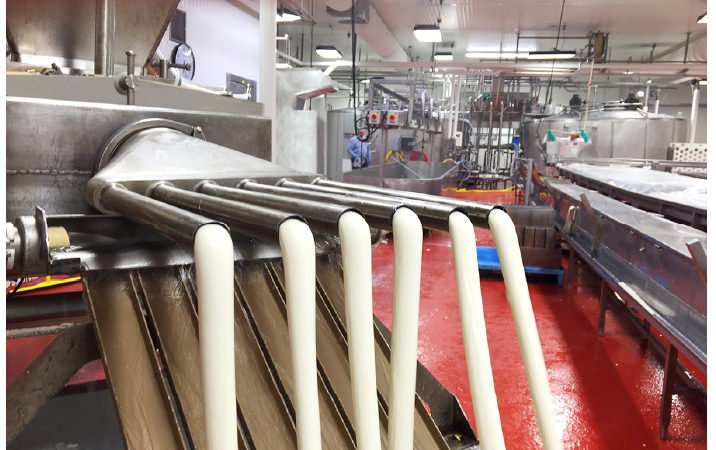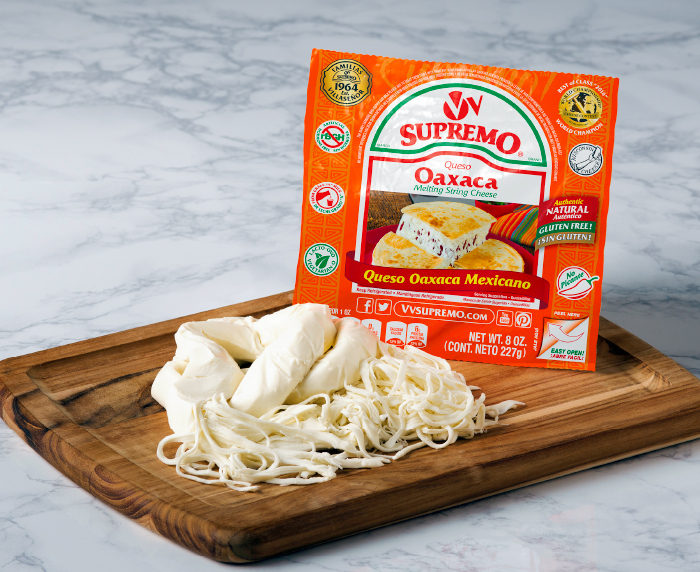Once a fairly rare cheese in the U.S., Oaxaca cheese production and sales have steadily grown. In fact, the USDA estimates that the U.S. volume sales for Oaxaca cheese were around 2,342,724 pounds in 2014, an increase of around 111,321 pounds since 2011. This growth has been an international effort, but thanks to a partnership between the CDR TURBO program and Chula Vista/V&V Supremo, Oaxaca cheese has found a new home in the dairy state.
“It was a little over five years ago when we first decided to develop our very own Oaxaca,” said Tom Dahmen, the plant manager at Chula Vista in Browntown, Wisconsin, a partner of V&V Supremo, Chicago, Illinois. “We pursued making it, but ran into a few problems along the way, so we contacted John Jaeggi at CDR.”
Having worked together on various projects over the years, Cheese Applications Coordinator John Jaeggi was aware of Chula Vista’s needs and the challenges that can come with manufacturing Oaxaca, a variety of cheese that is fairly labor intensive. In fact, due to the cheese’s unique set of attributes and its historical roots, pinpointing a make process that provided ideal function and historical accuracy created a unique challenge.
“Like many clients that work with CDR, we had provided Chula Vista with guidance, tech support and troubleshooting over the years,” said Jaeggi. “But, it was during one particular meeting with Chula Vista that we had the opportunity to discuss various options for their Oaxaca line. Chula Vista is very particular and they pay great attention to quality so we were very interested in helping them to extend their shelf-life while maintaining a smooth texture, buttery flavor and an ideal stringiness.”
“This was really a collaborative effort. Together we were able to successfully create a product, secure the WEDC funds and create new jobs in a rural area.”
Jaeggi and Dahmen began working together, along with their respective teams, in order to develop a make procedure for Oaxaca that would pay tribute to the variety’s historical roots while meeting consumer requests and expectations. The initial trials were performed in the CDR pilot plant at Babcock Hall because the multiple, small vat system allowed for many experiments to take place at one time.
“We have rather large vats at our plant, but coming to CDR to use their small vats allowed us to streamline our process,” said Alan Hamann, Senior Manager of Quality Control at Chula Vista/V&V Supremo. “It’s much more efficient and it allowed us to get to a solution quicker.”
After the initial trials at CDR proved to be successful, Dahmen and Jaeggi worked together to scale up the make procedure at the Chula Vista plant. Some adjustments were needed, but soon the process was officially up and running.
After that it didn’t take long for people to begin to take notice. In fact, the Chula Vista/V&V Supremo QuesoOaxaca Ball received the Best of Class award in the Hispanic Melting Cheeses (Quesos para Fundir class) at the 2016 World Championship Cheese Contest, earning a 99.85 out of 100.

As the success of the brand’s Oaxaca cheese grew, Chula Vista/V&V Supremo saw a need to expand production. Having previously made the cheese one or two days per week, the plant was now making the cheese five days a week in order to keep up with consumer requests. As such, new equipment and additional employees were needed, so the company reached out to the CDR TURBO program to see if there were any resources available to assist with the expansion.
The TURBO program, which is led by CDR’s Vic Grassman, is a comprehensive business accelerator designed to increase the speed of commercialization for new products and technologies specifically related to the dairy industry. More recently, however, the program has started to offer fee-for-service economic development assistance to Wisconsin dairy product companies to support their business growth. This assistance includes site selection, real estate expansions, capital equipment expenditures, entrepreneurial support services and help with workforce issues.
After discussing the options, Grassman and Hamann began working together to apply for grants and in 2016, Chula Vista/ V&V Supremo was able to secure a grant through the Wisconsin Economic Development Coorportation (WEDC) that allowed them to purchase some equipment needed to increase production. “This was really a collaborative effort,” said Grassman. “Together we were able to successfully create a product, secure the WEDC funds and create new jobs in a rural area.”
While the product has been launched and the equipment is in place, Chula Vista/V&V Supremo and CDR continue to work together.
“CDR has been great to work with,” said Dahmen. “The relationship has
been beneficial in both short and long term success. Between the hands
on and the theory, we know we can always call CDR to talk cheese.”


